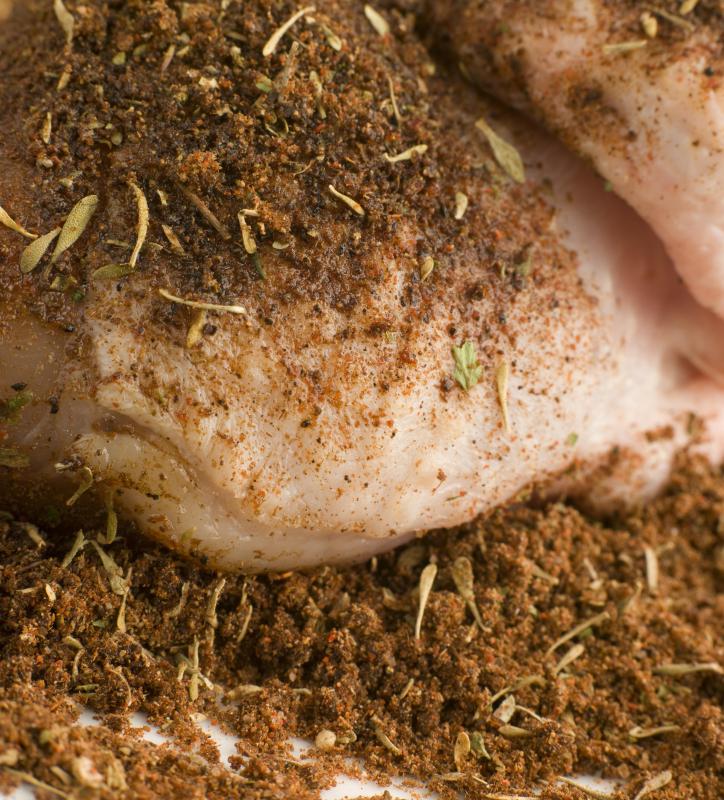At DelightedCooking, we're committed to delivering accurate, trustworthy information. Our expert-authored content is rigorously fact-checked and sourced from credible authorities. Discover how we uphold the highest standards in providing you with reliable knowledge.
What Is Rotisserie Pork?
Rotisserie pork is a cut of pork roast slow-cooked on a rotating spit over a steady heat source. The heat often comes from an open flame produced by a grill or fire pit, but it may also come from a standard electric heating element found inside a rotisserie oven. Cooking pork using this method results in moist, juicy meat, while quicker methods of cooking often cause pork to become dry and tough. Every cook has his or her own way of preparing a pork roast for rotisserie cooking, but most methods involve using a rub or marinade to add flavor. Some cooks even prefer roasting whole pigs over pre-cut pork roasts.
In its simplest form, rotisserie cooking is any method of cooking that involves cooking meat on a spinning axis over heat. This process usually takes hours to complete since the cuts of meat used are often large and the heat cooks the meat slowly. The oldest, original rotisserie method involved turning the axis by hand over a fire pit. Heat from the fire would indirectly cook the meat, but the fire did not usually touch the meat directly.

Modern day rotisserie cooking is done using mechanized devices. Some of these devices are little more than self-turning spits and are often used with outdoor grills or fire pits. Rotisserie ovens, on the other hand, are indoor appliances that contain electric heating elements and one or more self-rotating spit. These ovens have a door, and the meat cooks in a fully-enclosed space. Rotisserie pork roast can either be cooked using a rotisserie oven or a spinning spit over an open flame, but whole pigs must usually be cooked with a spit over a flame due to their large size.

While often done over a grill, rotisserie cooking is more closely related to roasting than grilling, which makes it a highly suitable method of cooking pork. When cooked quickly and with direct heat, pork has a tendency to dry out. Rotisserie pork, however, is usually juicier and more tender. When cooked over an open fire, the meat also takes on a smoky taste.
To prepare rotisserie pork, a cook first begins by determining the right amount of meat. An uncooked pork roast should weigh between 0.5 and 1 pound (approximately 0.23 to 0.45 kilogram) per anticipated serving, and a whole, dressed pig should weigh roughly 1.5 pounds (approximately 0.68 kilogram) per serving. The cook either uses a dry rub or a moist marinade to give the pork meat extra flavor. A dry rub includes salt, pepper, herbs, and spices, and is applied to the pork immediately before cooking. Marinades usually contain similar seasoning elements as rubs but also include a mildly acidic liquid — such as soda, lemon juice, or vinegar — that soaks into the meat and tenderizes it for a half hour or more before cooking.
Once the pork is prepared, the cook places it onto the spit, which usually detaches from the mechanized rotating device or oven in order to make this step easier. After the pork is on the spit and the spit is back in place, the cook turns on the rotating mechanism and allows the pork to continue cooking until done. Pork must reach an internal temperature of 160 degrees Fahrenheit (approximately 71 degrees Celsius) before it is safe to serve. This usually takes approximately 20 minutes of rotisserie cooking per pound (approximately 0.45 kilogram). By the end of the process, the juices should run clear and the rotisserie pork should have a crispy, golden exterior.
AS FEATURED ON:
AS FEATURED ON:












Discuss this Article
Post your comments